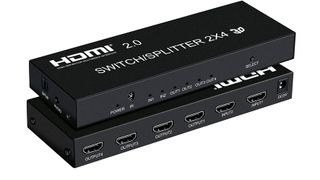Whether you went for a cheap HDMI (opens in new tab) cable or a fancy one, it makes no real difference to your splitting or switching situation. In both cases these boxes take in HDMI and output HDMI in varying numbers – and that’s the key to the difference between these two option. Read on to find out all you need to know about the difference between HDMI switches and HDMI splitters.
What’s the difference between HDMI switches and HDMI splitters?
To keep it simple, the difference between HDMI switches and HDMI splitters, is the number of HDMI cables going in and out. An HDMI switch will allow you to plug in lots of devices to the unit and then outputs a single HDMI to your device, like a TV (opens in new tab). This is a way to input multiple systems into one TV HDMI port. You can then switch between each one. Perfect for multiple video games consoles (opens in new tab) connected to a single TV. In the case of an HDMI splitter, you input just one device but can then output that using multiple HDMI cables to more than one device. Ideal for displaying one cable box feed to multiple TVs in the home, for example.
How do HDMI switches work?
HDMI switches break down into two basic formats: those that automatically switch between inputs and those that require you to physically switch between them. In the case of an auto switcher, you simply plug in your various devices and attach the single output HDMI cable to your TV. Then with the TV on you power up the device you’re going to use and the switcher will automatically feed that to your TV. The TV won’t know the difference, as it’s all coming into the same HDMI port. For a manual switcher you will find that most now come with a remote control, allowing you to switch which feed is being sent to the TV from the comfort of your couch. This means it can remain relatively hidden away, without the need to get physical access for switching. The benefits of an HDMI switch include a much tidier TV with just the one cable showing as well as more port space on your TV unit. It also means no faff with the TV remote as you can always leave it on the same HDMI, just powering up different devices connected to the switcher as you need.
How does an HDMI splitter work?
An HDMI splitter does as the name suggests and shares out a single input signal across multiple outputs. This could mean plugging in a single source, say from a cable provider box, and then having that output to two TVs in different rooms – presuming you have long enough HDMI cables for the job. While an HDMI splitter will share a signal across devices, keep in mind it won’t convert. So if you have a 4K source and are sending that to a 4K TV and a 1080p TV, it may only work on one if the other can’t handle that input.
What is a HDMI matrix switch?
There is a third type of device, often called an HDMI matrix switch, that combines the two. While a splitter could be a 3x1, with three input devices going out to one TV, and a switch could be 1x3, with one signal going to three TVs, there are other types. These have multiple inputs and outputs so work as both splitters and switches. For example you might go for a 2x4 unit which is able to input two signals out to four screens. So you could split one of those inputs across all four screens, or you could have two inputs going to the one screen.
Check for HDCP pass
In the case of splitters it’s worth keeping in mind that some devices can cause problems with HDCP handshakes. This is where an output device may be built in a way so that it won’t output to multiple screens, using a splitter, as the manufacturer didn’t want it to. In these cases going for a splitter that passes HDCP is important. The splitter manufacturer usually says this in the description if it’s a feature, so keep your eye out.
Get the right HDMI support
Whether you’re going for a splitter or a switch, you’ll need the right HDMI support to work with your device. So if you want to run a next-gen console out through a splitter, say, then you’ll want that splitter to be able to send the full-quality signal. Many splitters are HDMI 2.0 which is fine for must current gen devices, most offering 4K support. But if you want future-proof support for things like 120Hz and variable refresh rates, which the PS5 and XBox Series X use, then you’ll want to get an HDMI 2.1 toting device.












